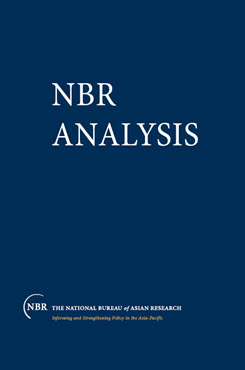NBR Analysis vol. 14, no. 2
Theater Security Cooperation in the U.S. Pacific Command
An Assessment and Projection
The September 11 terrorist attacks have radically altered the U.S. strategic position in the Asia Pacific.
Cooperative security activities have been an integral component of the U.S. Pacific Command (PACOM) for decades. By 2002, PACOM was involved in well over 1,000 annual discrete events with other countries’ armed forces, ranging from conferences and educational presentations through high–level representational visits by the Pacific Commander, counterdrug activities, humanitarian assistance projects, as well as bilateral and multilateral military exercises, to name only a few. Indeed, some 47 separate categories of Theater Security Cooperation (TSC) have been identified for PACOM. (See Appendix for a summary of PACOM TSC activities for 2001–02.)
The political environment in the Asia Pacific is extremely complicated. PACOM activities and exercises must take account of widely differing professional capabilities of the region’s militaries, from sophisticated (Japan, the ROK, Australia, Singapore) to those in a transitional stage (Thailand) to armed forces whose capabilities remain underdeveloped because of resource constraints (the Philippines). PACOM relationships with these partners must be crafted to take account of their differing capacities and to help improve their varying competencies. These ongoing ties between PACOM and the region’s armed forces constitute a kind of military diplomacy, which can create positive “spillover” effects in political relations. As the recent former Pacific Commander Admiral Dennis Blair and his co–author John Hanley, Jr. put it, “…to develop habits of cooperation, nations need not be signatories to a treaty alliance. They do not need a common enemy or national threat. They only need shared security interests and the willingness to work together.” [1] Thus, such PACOM exercises as search–and rescue and humanitarian intervention bring the armed forces of the region together in activities that provide mutual benefits.
Security pluralism was formalized in PACOM’s 1998 United States Security Strategy for the East Asia Pacific Region, which referred to the array of cooperative relationships and security frameworks that provided opportunities for non–bilateral treaty partners to work together, for example Japan and Australia. [2] These non–treaty and multilateral ties have emerged from the bilateral treaties that preceded them. Benefits from these relationships may be seen in how U.S. allies responded to September 11. Australia, South Korea, and Japan all committed forces to assist the U.S. effort in Afghanistan, though none had security treaty links to each other. A case could be made that PACOM’s efforts to develop capacities in the Asia Pacific for cooperative responses to such security requirements as peacekeeping under UN authority, search and rescue, and actions against varying forms of…
[1] Dennis Blair and John Hanley, Jr., “From Wheels to Webs: Reconstructing Asia-Pacific Security Arrangements,” The Washington Quarterly, vol. 24, no. 1 (Winter 2001): 9.
[2] Cited in Jonathon Gackle, “U.S.-Australian Defense Cooperation: A Model for Twenty-first Century Security Arrangements,” Defense and Security Analysis, vol. 18, no.1 (March 2002): 41–42.


